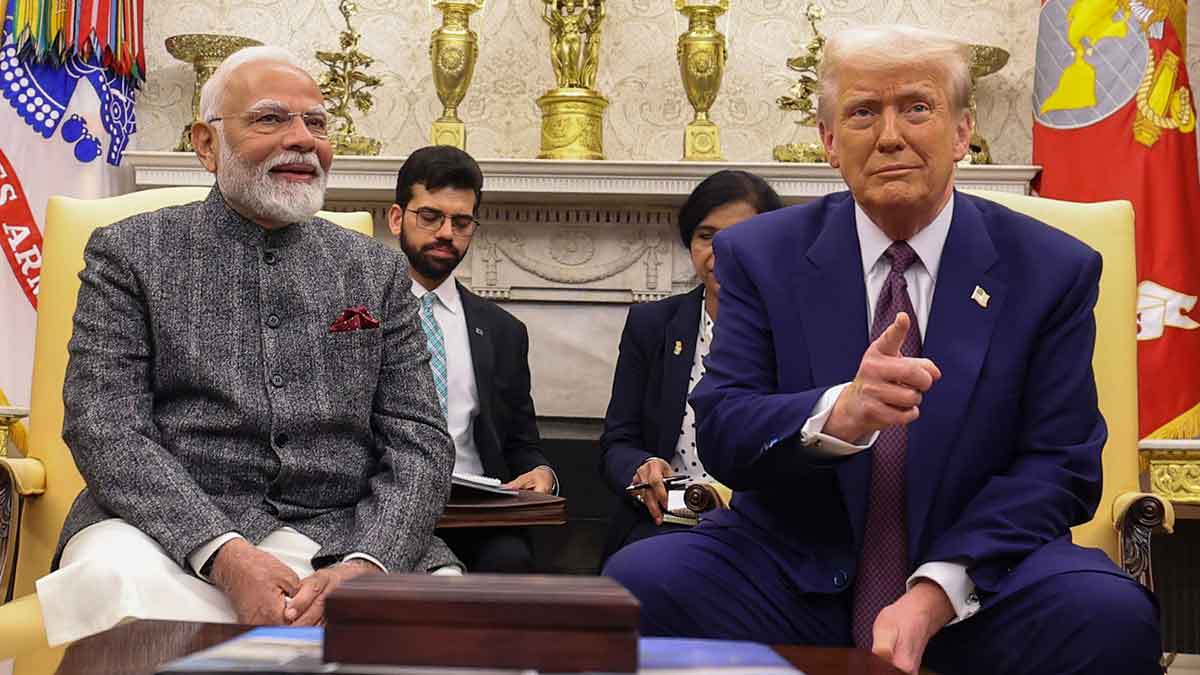Trump tariffs: Can India and US live without a trade deal?
 Uneasy alliance: Prime Minister Narendra Modi during a meeting with US President Donald Trump at the White House, in Washington, in February | PTI
Uneasy alliance: Prime Minister Narendra Modi during a meeting with US President Donald Trump at the White House, in Washington, in February | PTI
Picture abhi bhi baaki hain. That is the stoicism that India is trying to project after the latest round of some rather troublesome Trump tantrum, where he as much as coupled India with Russia and quipped like a jilted lover, “I don’t care what India does with Russia. They can take their dead economies down together, for all I care!”
Both nations’ businesses, traders and the larger consuming population do care, and they care very much. Trump does, too, even if he may quaff to admit it. So does Modi and his commerce minister Piyush Goyal, despite all his ‘atmanirbharta’ chest-thumping in Parliament.
The nitty gritties apart, an agreeable deal would have sewn up things quite nicely for both the nations. For the US, strategic ally India becoming a larger trade presence would have provided a nice counterbalance to China and even brothers-in-arms EU, even while providing American businesses an access to the world’s biggest open consumer market by numbers. For India, America is already its biggest trading partner, and the perfect antidote to its walking away from the China-led RCEP, the world’s largest trading bloc.
But months after a Bilateral Trade Agreement (BTA) roadmap was announced, and after all the tariffs and postponement we’ve come to no happy ending yet – even the latest, Trump’s 25 per cent tariff to be imposed from August 1, comes with a lot of addendums – there is a ‘plus penalty’ for trading with Russia which is yet to clearly deciphered. Meanwhile there is the standard 25% on steel and aluminium that has been universally imposed.
“Various sources have termed it as “tariff bomb’, but it’s more of a ‘bomb hoax’, quipped V.P. Singh, professor of economics and director PGPM at the Great Lakes Institute of Management in Gurugram.
Many, including on the Indian government side, believe this to be the case – a mere negotiating tactic ahead of the next round later in August, considering India’s adamant stance so far, especially regarding opening up of agriculture and dairy sectors to American imports. In fact, Trump may also have just have bitten off more than he can chew, considering the tough sounds Goyal made in Parliament, and the narrative in the public space.
Singh echoes this. “Short term inconvenience to some exporters is expected but US can’t undermine India’s interests. Moreover, market access to US agriculture and dairy products can’t be permitted at the cost of our farmers’ interest. Geopolitics requires India to keep Russia as an ally.”
In fact, it could be educative to look at the trade scenario between the two nations just get an understanding of why India is playing a hard deck of cards at the negotiating table. While New Delhi is dependent on China for crucial raw materials and thus any tough stance from Beijing, like the present blocking of magnets and rare earth minerals, hurts in the long run, when it comes to Washington, it is more than just a numbers game. India exports just $86 billion worth of goods to the US, while it imports barely goods worth $45 billion – not only is there a surplus, the significant point is that except for a few American products like GPU chips (which are rationed any which ways) and other high-end devices, most of India’s imports from America are products that can be easily substituted from elsewhere.
But the situation is not the same when it comes to America, with generic drugs from India forming a crucial crutch to America’s public health system. Any sudden stoppage to this, or even a price rise (Trump last fortnight threatened to impose 200 per cent tariffs on pharma sector).
“Trade dynamics need to be seen through multiple angles,” said Singh, pointing out to the deals carved out the UK with US as well as India.
More than trade, where it will pinch India are in the labour-intensive sectors like textiles as well as gems and jewellery, major source of exports to the US. But this is where India has, though rather late, reached out for other strategic trade deals – the one with the UK is already done and dusted, while all hopes are pinned on the ongoing talks with the EU.
For India, the loss of a deal with the US doesn’t work out, is more notional – it was a golden chance to step up as a future powerhouse by becoming a manufacturing hub in place of present bulk goods exporter biggies to the US like China, Vietnam and Indonesia. Here is where the 25% slab will hurt, because for India to become competitive enough, nothing less than a tariff slab of 15 per cent would have worked.
This is because while China’s discussions are ongoing but still the slab at best is around 30 per cent, many others have gained a favourable deal for themselves.
Take, for example, Vietnam, which was the big winner in the whole ‘China + One’ move of many international manufacturing biggies after Covid. Vietnam has walked away with a 20 per cent tariff, while Indonesia, another contender, bagged a 19 per cent concession. On the western front, UK has a 10 per cent tariff while the EU got to 15 per cent.
This means simply that for India to attract future manufacturing businesses on a global scale, a lower tariff from the US is crucial, considering the size of America’s domestic market. Already, Apple’s bet on India is under the scanner, with its stocks falling on Thursday. India’s next moves – aggressive or conciliatory, will be keenly watched.
Business